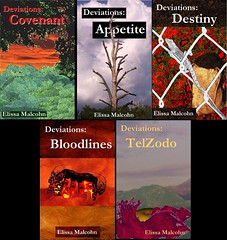Science Poems for January 2011: 26
Last April I posted a science sonnet a day in celebration of National Poetry Month (index with links here). This month I am posting a science poem a day, written in various traditional forms, in honor of Science Online 2011.
The "fifth annual international meeting on Science and the Web" ran from Jan. 13-16. Click on the logo below to access the conference page, which has links to posts, tweets, photos, and videos from the event.

As with the sonnets, my January poems take their cues from science-based articles. I also have two works in a special science poem section (vol. 33 #5/6) of Star*Line, journal of the Science Fiction Poetry Association. You can read my "Ciliate Sestina" here.
Also, two sonnets from last April's collection, "In Development" and "Manipulations," have made it into Open Laboratory 2010. Click on the badge below for links to the 50 essays, 6 poems, and 1 cartoon in the collection.

(Click here to see Andrea Kuszewski's gorgeous cover!)
Today's poem takes its cue from "Quantum states last longer in birds' eyes " (Rachel Courtland, New Scientist, Jan. 20, 2011). Click on the article link to learn more about the research. To learn more about the traditional poetic structure used, click on the form name.
Second Sight
(Form: Italian Sestets)
Magnetic fields can give a bird direction
When seasons change and time to migrate looms,
But how that's done has been a mystery.
Now theories of a quantum spin reflection
(Entangling of electrons, one assumes)
Might well explain a robin's faculty.
Within its eyes electrons are excited.
Light separates a pair, one on each molecule,
Yet they still spin in synchronicity.
But soon enough, this pas-de-deux is slighted.
Magnetic shifts affect a chemical
And orient the bird appropriately.
The robin is attuned to tiny changes:
Just 15 nanoTesla cause confusion.
Less than one-thousandth of our planet's force
Disrupts the avian as forth it ranges,
Creating navigational illusion,
Enough to throw the wanderer off course.
Its inner compass works (and could be thwarted)
As long as those electrons are entangled,
Existing in a short-lived quantum state.
Without those spins, its flight plan is aborted.
But somehow, in its brain, the bird has wangled
A longer-lasting way to operate.
Engaging for one hundred microseconds,
Those tangled spins retain coherence best,
Compared to molecules that we've designed.
It's led a team of scientists to reckon
That our techniques might someday pull abreast
Of mechanisms nature has refined.
Elissa Malcohn's Deviations and Other Journeys 
Promote Your Page Too

Vol. 1, Deviations: Covenant (2nd Ed.), Vol. 2, Deviations: Appetite, Vol. 3, Deviations: Destiny, Vol. 4, Deviations: Bloodlines, Vol. 5, Deviations: TelZodo
Free downloads at the Deviations website, Smashwords, and Manybooks.

Proud participant, Operation E-Book Drop (provides free e-books to personnel serving overseas. Logo from the imagination and graphic artistry of K.A. M'Lady & P.M. Dittman); Books For Soldiers (ships books and more to deployed military members of the U.. armed forces); and Shadow Forest Authors (a fellowship of authors and supporters for charity, with a focus on literacy).

This work is licensed under a Creative Commons Attribution-NonCommercial-ShareAlike 2.5 License.
The "fifth annual international meeting on Science and the Web" ran from Jan. 13-16. Click on the logo below to access the conference page, which has links to posts, tweets, photos, and videos from the event.

As with the sonnets, my January poems take their cues from science-based articles. I also have two works in a special science poem section (vol. 33 #5/6) of Star*Line, journal of the Science Fiction Poetry Association. You can read my "Ciliate Sestina" here.
Also, two sonnets from last April's collection, "In Development" and "Manipulations," have made it into Open Laboratory 2010. Click on the badge below for links to the 50 essays, 6 poems, and 1 cartoon in the collection.

(Click here to see Andrea Kuszewski's gorgeous cover!)
Today's poem takes its cue from "Quantum states last longer in birds' eyes " (Rachel Courtland, New Scientist, Jan. 20, 2011). Click on the article link to learn more about the research. To learn more about the traditional poetic structure used, click on the form name.
Second Sight
(Form: Italian Sestets)
Magnetic fields can give a bird direction
When seasons change and time to migrate looms,
But how that's done has been a mystery.
Now theories of a quantum spin reflection
(Entangling of electrons, one assumes)
Might well explain a robin's faculty.
Within its eyes electrons are excited.
Light separates a pair, one on each molecule,
Yet they still spin in synchronicity.
But soon enough, this pas-de-deux is slighted.
Magnetic shifts affect a chemical
And orient the bird appropriately.
The robin is attuned to tiny changes:
Just 15 nanoTesla cause confusion.
Less than one-thousandth of our planet's force
Disrupts the avian as forth it ranges,
Creating navigational illusion,
Enough to throw the wanderer off course.
Its inner compass works (and could be thwarted)
As long as those electrons are entangled,
Existing in a short-lived quantum state.
Without those spins, its flight plan is aborted.
But somehow, in its brain, the bird has wangled
A longer-lasting way to operate.
Engaging for one hundred microseconds,
Those tangled spins retain coherence best,
Compared to molecules that we've designed.
It's led a team of scientists to reckon
That our techniques might someday pull abreast
Of mechanisms nature has refined.


Free downloads at the Deviations website, Smashwords, and Manybooks.
Proud participant, Operation E-Book Drop (provides free e-books to personnel serving overseas. Logo from the imagination and graphic artistry of K.A. M'Lady & P.M. Dittman); Books For Soldiers (ships books and more to deployed military members of the U.. armed forces); and Shadow Forest Authors (a fellowship of authors and supporters for charity, with a focus on literacy).











0 Comments:
Post a Comment
<< Home